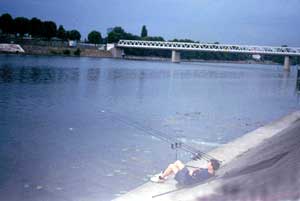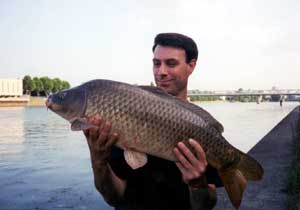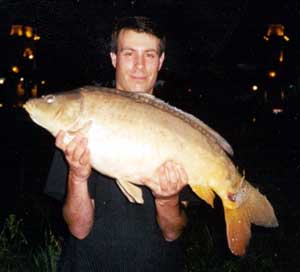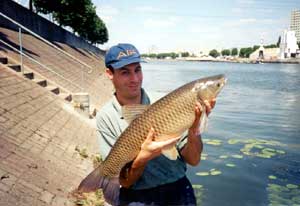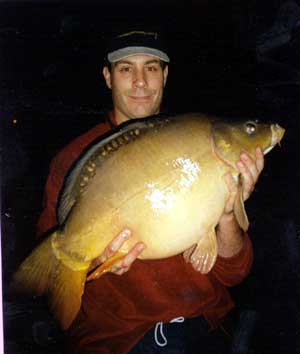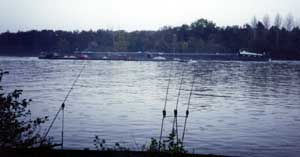My fishing has been severely restricted of late,having slipped a disc in my back last September and then being faced with moving house and some big changes at work as well. This all added up to me not being able to fish for several months, so all in all I was not a happy chappy! To try and take my mind off things I thought I would put together an article for Graham for if you cannot actually go fishing the next best thing has to be reading or writing about it!
The aim of this article is to try and recount some of my experiences of fishing short sessions for river carp in 2001, and to try to pass on a few tips on how I approached these sessions – or at least showing you where I went wrong so you don’t make the same mistakes!
This was the plan
|
|
| |
Choosing a venue
Choosing a suitable venue was obviously the first decision I had to make and if you are considering going for a short session approach I would say that this is the single most important aspect that you need to get right if you are going to avoid becoming disillusioned. Let’s make no bones about it, picking somewhere close and easy to get to is going to be a major advantage and a damn sight easier to fish on short regular sessions than one that takes ages to get to. The question of how far that should be is really a personal one as people will have different personal circumstances and some will be prepared to travel further than others. My own self-imposed limit was a venue that was no more than 30mins travel time each way. This was based on balancing the amount of fishing time against the amount of travel time, the cost of petrol, and trying to hold down a full time job.
Setting targets
The second point I had to decide on was what my targets were going to be. It’s important to think carefully about what you are trying to achieve during these sessions and adjust your goals to take into account the size and stock of fish that are present in the venues within striking distance of you. There is no point picking a short session venue with a monster in it if it takes you two hours to get there, and there’s no point setting your sights on a whacker from the duck pond down the road if it does not hold one. Setting realistic goals means you won’t become disillusioned.
|
|
| |
Baiting ideas
When it comes to the actual fishing the short session angler is faced with two basic choices. He can either go looking for the fish or he can attempt to bring them to him. For the guy fishing a small heavily featured venue stalking may well be a viable short session tactic, but on larger, bleaker venues, it’s probably better if you can bring the fish to you with the use of bait. In my case the river where I was fishing was a big uniform venue similar to the tidal Thames. The fish had a lot of water to lose themselves in and I simply did not have the time to go looking for them each session. What I was looking to create was a situation where, if possible, I was setting up on or very close to fish each time I arrived.
The short session angler has one huge advantage in this respect over the guy who fishes just occasional longer sessions, and that is quite simply his ability to chuck bait in on a regular basis! This simple point really can make the difference between getting average results or exceptional ones and fishing to prebaited swims is the best way to stack the odds in your favour. However, as the main emphasis for me on these sessions was on having fun I did not want to enter into a massive prebaiting campaign, throwing tons of bait in over weeks and weeks before fishing (which, it has to be said, can work unbelievably well!). Instead I made a decision to bait a number of swims lightly but very regularly.
I started out by putting in just a pound or so of bait into a handful of swims every day for a week before beginning fishing, and then continued to bait each of them on every visit over the following months. I would certainly recommend to anyone contemplating short regular sessions to also bait several swims and not just rely on the one swim. By rotating between the baited swims it is possible to keep fish coming and extend the life of a swim longer than if you just flog one swim to death. You also have the option of somewhere else to fish if someone is already in your first choice. For bait I settled on using mainly bulk purchased particles with some dog biscuits and a few boilies mixed in. The emphasis was on keeping everything cheap and in plentiful supply. For venues where the fish are not hammered I think keeping the bait going in regularly is more important than worrying too much about using super duper ingredients.
A word of warning
|
|
| |
I tended to bait up at the end of a session under the cover of darkness, which also had the added benefit that the majority of bird life could not see me either. Its amazing the number of animals willing to clear you out of bait given half the chance.
Being on a river the other factor I had to take into account when baiting was the current and boats. Some really big, deep-running barges cruised up and down the length and the wash from these was enough to scatter a tightly baited patch all over the place. I wanted to be sure that any bait I put in stayed where it was until it was eaten. Taking this into account I tried to bait close to the bank and in slack areas behind obstructions that jutted out into the river. Not only did these obviously divert the current but the boats tended to swing out and around these into mid river lessening their bait-spreading effect. The other big advantage of baiting close in also meant I could bait up by hand. That may seem like a small point, but believe me, if you are fishing lots of regular sessions and trying to bait several swims each time, it can become a real chore to have to pick out yet another rod complete with spod or mess around with a throwing stick or catapult to get the bait out at the end of every trip. My advice is keep it close and just chuck it in by hand if you can get away with it. It will save you a lot of time and you can be virtually guaranteed of accuracy, you will also be amazed at how close fish can be drawn in once they know a regular supply of food is available.
Travel light
It is common sense to realise that tackle on short sessions of three or four hours should be kept to a minimum. Some of you may think that goes without saying but I can recall several times when I have seen anglers arrive at a water mid-morning, set-up a bivvy, bed chair, stove and all the other paraphernalia only to then pack up at dusk! Banksticks, net, mat and a small rucksack with a few bits of tackle, scales, camera and a bit of bait were all that was needed.
|
|
| |
In addition to keeping things light I also try to have as much equipment ready prior to arriving as possible. Have your rods already tackled up, buzzers and indicators on the buzz bars and all the bits and pieces ready in one bag. Then you will find it’s just a case of unfolding the pod or plonking in the bank stick and fitting the rods together when you arrive. I didn’t need to mess around with a marker rod each session as the plumbing ground work had already been done prior to baiting the swims, and in some cases I even had the bait on the rods and wrapped in cling film. By doing this I could literally have three rods out within 5 minutes of arriving.
If you are only going for three hours spending 45 minutes setting up is not a great idea.
Approach to the fishing
The way I approached the fishing itself was to fish the baited swims in rotation, one each session. If I caught a carp I would fish the next session in the same swim or if I did not catch I would move to the next one. The important point was that all the swims received bait each visit regardless of if I fished them or not.
Generally I found the first fish to move onto a baited patch were bream and tench. I always looked on this as a good sign as their activity helped to draw in the carp. In fact, so important was this point to me that if I was not receiving any bream or tench action after a number of baitings then I would drop the swim altogether and find a new one. Once you start getting indications that fish are present it is important to keep the bait going in and stepping up the feed if the head of fish in the swim seems to be very large. Rest assured in this situation that if your venue has a fair head of carp and you can keep the bait available to them then they will find it eventually.
|
|
| |
My results over the next few months were very encouraging. I still remember the first time I cast into one of the baited swims, this being somewhere I had fished a number of times previously with sporadic results. Immediately after casting it was obvious that the swim was alive with fish as I was receiving lots of little twitches and pulls and literally within 10 minutes the outside rod was off to a flier and a lovely dark common came to the net. Results after that continued steadily, and although I never ‘bagged up’ as such it was obvious that the steady baiting was leading to far more consistent results than before. Tench and bream continued to gatecrash the swims but also some surprises started to turn up, the highlight being a grass carp, the first one from the Seine I have ever seen or heard about and what must have been quite a rare capture. The majority of the carp were the expected doubles and low twenties but I was fortunate enough to latch into a couple of the bigger fish which, although I had tried to be selective by using some huge baits, were probably pot luck captures given the head of head of other fish around.
I made mistakes
|
|
| |
Second error was that I tended to put very little bait in while I actually fished. I had assumed that the more bait in there at the time of actually fishing the less chance there was of the hookbait being picked up. However, I got the definite impression that the fish were coming into the swims in big groups and would move on quickly if no bait was present, as I would catch one carp then nothing else. It was only after I tried putting some bait out at the beginning of the session that I started to get some multiple catches.
I well remember the first evening I tried this. I decided to put out a fair bit of bait at the start and then sat back thinking I had blown it only to have two fish on simultaneously within the first 30 minutes. The chances of them both being unlucky enough to pick up the hookbaits from amongst all the freebies was remote, so more than likely it was a large shoal that had moved in and was clearing me out! Unfortunately I did not realise this until quite late on and did not get a chance to follow up on the theory.
All in all I really enjoyed fishing these sessions. It was great to be able to fish after work without having to drive miles or being weighed down with a ton of tackle. I shall certainly be continuing with the short sessions again this year.
If you’re an out and out session angler, give it a go as you might find it an enjoyable alternative.










